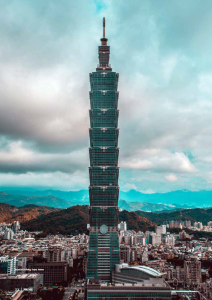
According to historical records, in 1544, Portuguese sailors first passed by the island of Taiwan on their way to Japan. Sighting the island, which was uncharted at the time, they marked the island on their maps as Ilha Formosa (“Beautiful Island”). While there are no records of the Portuguese landing and establishing a foothold there, their naming of Taiwan as Ilha Formosa endured for centuries. Other European sailors would call the island by this name until the early 1950s.
“Beautiful Island” would just about aptly describe Taiwan. A vibrant and dynamic place with beautiful natural landscapes, a rich cultural heritage and an exciting modern lifestyle, Taiwan has something to offer everyone – whether you are a nature lover, history buff or foodie. In this travel piece, we take a spin around some of Taiwan’s key attractions to discover the things that make this beautiful island one of Singaporeans’ most favoured destinations.
TAIPEI
Taipei, the lively capital city, is the main gateway into Taiwan, and a fascinating destination by itself. With a number of flights operated daily by different airlines to Taoyuan International Airport, Taipei is extremely easy to access. Once you reach the city itself, Taipei offers an exciting mix of experiences. The city is a splendid example of everything that makes Taiwan such a popular destination.
Ask any Singaporean about visiting Taiwan, and the first thing that pops into his/her mind is likely to be delicious Taiwanese food. Food is a huge part of Taiwanese culture, and a reflection of its long history. It is greatly influenced by Japanese cuisine, various regional Chinese cuisines as well as indigenous food. Taipei is home to some of the best food in Taiwan: from street vendors selling tasty local food to high-end restaurants serving up delicious international fare.
Taiwanese street food is possibly among the best in the world. Some of the must-tries include xiao long bao (steamed pork dumplings filled with broth – made famous worldwide by Din Tai Feng); lu rou fan (braised pork rice); oyster mee sua (thin wheat noodles with oysters in a thick soup gravy); stinky tofu (deep fried fermented tofu cubes served with pickled cabbage and chilli); beef noodles; grilled Taiwanese sausages; stewed medicinal pork ribs; and the very famous big fried chicken fillet.
The best place to sample these classic Taiwanese foods is at its famous night markets, where you can sample many of these dishes at affordable prices. One of Taipei’s most famous and largest night markets is the popular Shilin Night Market. Located with walking distance of Jiantan Station (Red line), Shilin has a long history dating back to 1899. The market is famous for its many delicious foods, including the very famous Hot Star Large Fried Chicken, which made its way to Singapore many years ago. Other stalls which you may want to try in Shilin include Ah Hui Mee Sua (listed in the Michelin Guide), Hao Peng You Cold Noodles, Zhong Jia Yuan Shanghai Fried Buns, Hai You Medicinal Pork Ribs (all Michelin Bib Gourmand listed), and the popular Zhong Cheng Hao Oyster Omelette.
Alternatively, you can also make your way down to Raohe Night Market, another popular night market in Taipei, to get your fill of delicious Taiwanese street food. Located within walking distance from Songshan Station (Green line), look for Exit 5 and walk along Guangfu South Road until you see the famous red lanterns marking the entrance to the market, next to Ci You Temple.
Raohe Night Market also has a number of Michelin Bib Gourmand listed eats. They include Ah Guo Lu Wei (try their braised duck wings, rice cakes, tofu and bean curd skin), Beef Noodles and Offal Soup (the stall has no name, and only has a cartoon cow logo on a yellow sign), Chen Dong Medicinal Pork Ribs, and Fu Zhou Shi Zu Black Pepper Bun.
Besides these two popular markets, other prominent night markets you can visit in Taipei include Linjiang Street Night Market, Nanjichang Night Market, Ningxia Night Market, Yansan Night Market, Gongguan Night Market and Huaxi Street Night Market. These markets also have a number of Michelin Bib recommended stalls. However, do note that accessibility varies, with some located fairly close to MRT stations, while others require a fair bit of walking.
Besides its famous night markets, there is plenty of sightseeing to do in Taipei as well. If you are visiting Taipei for the first time, you will want to pay a visit to the iconic Taipei 101. This skyscraper, one of Asia’s tallest buildings, is accessible via the Taipei 101 Station (Red line). Taipei 101 offers stunning views of the city from its observation deck (Level 101), and indoor and outdoor observatories (Levels 89 and 91). In order to access these levels, you need to purchase your ticket at Level 5 – the lift entrance for the upper observation levels.
The high-speed lift, one of the fastest in the world, will take you from Level 5 to Level 89 in about 37 seconds. At Level 89, you will get a panoramic view of the city from an indoor observation area. If you wish to go even higher to get a feel of the outdoor air, you may climb a flight of stairs to hit the outdoor observatory at Level 91. Alternatively, at Level 5, you can buy a higher priced ticket to access the top-level outdoor observation deck at Level 101. Do note that the opening hours of these outdoor areas are subject to weather safety considerations.
Besides the observation areas, Taipei 101 also houses a luxury shopping mall as well as a number of great restaurants from Basement 1 to Level 4. The number of world-famous luxury brands in the shopping mall is eye-watering, including the likes of Chanel, Dior, Cartier, Louis Vuitton and Prada. You can easily shop to your heart’s content. In terms of food choices, B1 is a dedicated dining area that has many affordable eats, including the homegrown Din Tai Fung, and an assortment of other local and international restaurants. If you wish to pamper yourself, drop by the high-end restaurants on Levels 4 and 5. There are also a few high-end restaurants located at the higher levels (Levels 85, 88 and 89) where you can catch a magnificent view while enjoying your meal.
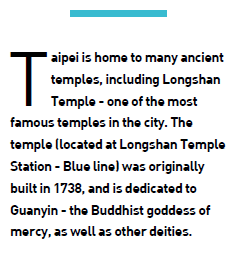
For history and culture buffs, the Chiang Kai-shek Memorial Hall (drop at Chiang Kai-shek Memorial Hall Station – intersection of Red and Green lines) is a must-visit. A national monument dedicated to the former President of Taiwan, the hall was completed in 1980, with a design that is heavily influenced by traditional Chinese architecture. The roof of the hall is adorned with blue tiles, and the exterior is made of white marble. The building is flanked by two large ceremonial gates, and a large plaza leads up to the main entrance.
Inside the hall, you will see an impressive statue of Chiang Kai-shek sitting on a throne. The bronze statue stands at over 6m tall. The walls of the hall are decorated with murals depicting significant events in Chiang Kai-shek’s life, as well as calligraphy and other artwork. There is also a museum dedicated to Chiang Kai-shek and the history of Taiwan. It features exhibits on the political, economic and cultural history of Taiwan, as well as artifacts from Chiang Kai-shek’s life. Once you are done exploring the hall and the museum, do take a walk in the surrounding gardens as well. And if you are feeling peckish, drop by the famous Jin Feng Lu Rou Fan (located about 50m away from Exit 2 of Chiang Kai-shek Memorial Hall Station) for a delicious bowl of braised pork rice and a variety of palate cleansing soups.
Taipei is home to many ancient temples, including Longshan Temple – one of the most famous temples in the city. The temple (located at Longshan Temple Station – Blue line) was originally built in 1738, and is dedicated to Guanyin – the Buddhist goddess of mercy, as well as other deities. It is known for its stunning architecture, which combines elements of both traditional Chinese and Taiwanese styles. Longshan Temple is a popular spot for locals to come and make offerings, and pray for good luck and blessings. In addition to its religious significance, Longshan Temple is also a cultural landmark that has been featured in numerous films and TV shows, including the popular 2010 gangster film Monga.
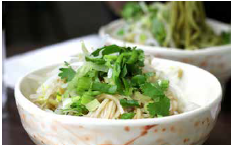
Besides cultural landmarks, Taipei is a shopper’s paradise, and there are a number of different shopping locations that cater to different budgets. For an upmarket shopping experience, you can start with the Xinyi District, where Taipei 101 and another high-end shopping mall Bellavita Mall are located. But if you are looking to shop affordably, there are plenty of other cheaper options in the area as well, including the Shin Kong Mitsukoshi A11 and A13 Malls, and ATT 4 Fun. Xinyi District is also home to Eslite Bookstore – a must-visit destination for anyone visiting Taipei. The chain’s flagship location in Xinyi District (open 24 hours) offers a huge selection of books, magazines and other media, as well as a variety of affordable souvenirs and gifts in the store’s gift shop.
Besides Xinyi District, other must-visit shopping destinations in Taipei include Wufenpu, a wholesale market that is popular for its affordable clothing and accessories; Guanghua Digital Plaza, a one-stop destination for affordable electronics; Taipei Main Station Underground Mall, a mile-long paradise of cheap goods and great finds; and Yongkang Street, a great place to buy cheap souvenirs and snacks for family and friends in Singapore.
If you have had enough of urban delights, and want to escape the hustle and bustle of the city, you might want to spend a day out visiting the beautiful natural landscapes and countless hot springs located on the outskirts of Taipei. For hot springs, take a trip out to Beitou Hot Springs, one of Taipei’s main hot spring towns, and a popular destination for both locals and tourists. Beitou Hot Springs (take the train all the way to Xinbeitou Station (Pink line) – one station off Beitou Station (Red line)) is known for its hot springs’ healing properties and the area’s stunning natural beauty.
Beitou Hot Springs is situated in a valley surrounded by mountains, providing a tranquil surrounding while you soak in mineral-rich waters, which are naturally heated by geothermal activity and is believed to have healing properties for the skin and respiratory system. There is a variety of hot spring options you can choose from, ranging from public hot springs to private resorts. Some of the most popular hot spring resorts in the area include the Grand View Resort Beitou, the Spring City Resort Beitou and the Villa 32 Beitou. These resorts also offer spa treatments, such as massages and facials, for a truly indulgent experience. Besides the hot springs, the town has a number of public parks and trails, which offer scenic views of the mountains and hot springs. Take some time to go on a scenic hike through the surrounding mountains in this tranquil oasis.
Yangmingshan National Park, with its natural beauty, hot springs, hiking trails and cultural landmarks, is another great place for a day getaway from the Taipei cityscape. One of nine national parks in Taiwan, Yangmingshan is considered by many to be one of the best hiking areas in Taiwan, and one of the country’s busiest national parks. Here at Yangmingshan, not only will visitors get to enjoy the mountainous terrain and its multiple hiking trails, hot springs and cherry blossom viewing spots, the park is also home to 1,400 unique plant species and Mount Qixing, Taiwan’s tallest dormant volcano.
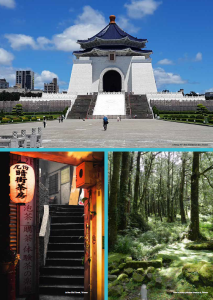
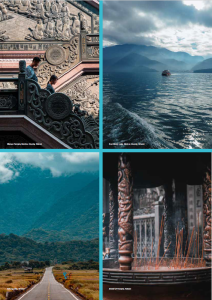
In terms of hiking, Yangminshan has a wide network of well-marked short and long trails that offers something for everyone. Among the most popular trails in the park is the Mount Qixing Trail, a four-hour hike that is suitable for those of average fitness. At the end of the trail, you will get a magnificent view of the park from the top of Mount Qixing. It is a great choice if you have a day to spare in the park and want to make the most of it.
If you have less time but still want to hike, you might want to take the Mount Zhugao Trail. This is a short hike that branches off the Qingtiangang circular trail. It passes through meadows and flowers, with a stone path to the peak that offers a 360-degree view of the park. This novice-friendly walk should take around an hour. Alternatively, the Erziping Trail also offers a gentle walk that will allow you to enjoy the beauty and nature of the park.
One of the most popular attractions in Yangmingshan is the Lengshuikeng Hot Springs, which is located in a volcanic crater and is renowned for its healing properties. You can soak in the natural mineral-rich water, and enjoy the surrounding landscape of misty mountains and lush forests, making for a truly unforgettable experience.
One of the most popular attractions in Yangmingshan is the Lengshuikeng Hot Springs, which is located in a volcanic crater and is renowned for its healing properties. You can soak in the natural mineral-rich water, and enjoy the surrounding landscape of misty mountains and lush forests, making for a truly unforgettable experience.
In addition to its natural attractions, Yangmingshan is also home to a number of cultural and historical landmarks, including the Zhongxing Guest House, which was built during the Japanese colonial period and served as the residence of the governor-general of Taiwan, and the Yangmingshan Flower Clock, which was built in 1967 and is one of the most famous landmarks in Taipei. The clock is made up of over 3,000 flowers and is set against a backdrop of misty mountains and lush forests, making for a wonderful photo opportunity.
MIAOLI
Before hitting other destinations on the way down south, we recommend a day stop at Miaoli – one of the most overlooked tourist locations by foreigners. Miaoli’s rustic charms are not often publicised to the outside world, but they are well-known to locals. During weekends, you are likely to see many locals coming to the area for a weekend getaway.
The majority of Miaoli’s attractions lie outside the city. For starters, you can do some strawberry picking at the town of Dahu (accessible by bus from Miaoli Station) – popularly known as Taiwan’s strawberry kingdom as 80% of Taiwan’s strawberries are grown here. During strawberry season every year (from December to April, with January and February being the peak months), many local visitors flock to Dahu to pick their own fruit. First, learn more about the area and its unique agriculture by heading to the Dahu Strawberry Cultural Centre, where you can find out more about strawberry ecology and the local industry, as well as buy some gifts. From there, you can then go on to a nearby strawberry farm (there are dozens to choose from) to pick strawberries.

Another attraction you should visit during your sojourn in Miaoli is Mount Shitou. Standing at 491m high, Mount Shitou is the most important Buddhist and Taoist sacred mountain in northern Taiwan. In 1895, a Buddhist monk established a temple in a natural cave, after which Quanhua Hall and other temples were successively built. Most of the temples built are Buddhist, and many exhibit Japanese influences. At present, there are 11 temples scattered across the front and rear mountains, which are linked by the Shishan Historical Trail. Approximately 5km long, this trail is a good route to go for Buddhist worship, to admire the scenery, and to do some hiking.
TAICHUNG
The next stop from Miaoli is Taichung. While the city offers plenty by itself, one of the main reasons why people come to Taichung is because the city is the transit point for the famous Sun Moon Lake. To head to Sun Moon Lake, you can take the tourist shuttle bus (90 minutes) from Taichung Station or from Taichung HSR (High-Speed Rail) Station (which is the fastest way to get around the various cities in Taiwan, but do take note that some HSR stations are located outside the cities). This shuttle bus is included in the Sun Moon Lake Pass, a special pass that includes bus rides and some activities at the destination. Alternatively, you can also take a shared or private transfer from Taichung to Sun Moon Lake.
Sun Moon Lake is Taiwan’s largest lake and hosts over six million visitors a year. It is so-named because the lake is shaped like a sun on the eastern side, and like a moon on the western side. The main arrival point for Sun Mon Lake is the village of Shuishe on the northwest side of the lake. The Sun Moon Lake Visitor Centre is located here, while the village also has a number of restaurants, accommodation and other facilities to cater to the needs of visitors.
The key attraction of Sun Moon Lake is its incredible beauty. Surrounded by the western foothills of the Central Mountain Range, the lake is a gem at the foot of Taiwan’s mountainous crown. To fully appreciate the beauty of the lake, you need to see it from a higher vantage point. You can do this at the Wenwu Temple, Ci En Pagoda or the Sun Moon Lake Ropeway. The lake’s other main village, Ita Thao, is located on the southeast side of the lake. Ita Thao is less touristy than Shuishe, and has a number of guesthouses that offers good, yet affordable accommodation for the night. There is also greater access to the waterfront as well as a night market where you can sample excellent aboriginal fare, including local specialties like wild boar meat, Zhu Tong Fan (bamboo tubes of sticky rice), and millet wine.
Besides Sun Moon Lake, another excellent day trip form Taichung is Cingjing. At an elevation of nearly 1,750m, Cingjing, with its cool European-inspired architecture and proximity to Hehuanshan – one of Taiwan’s highest peaks, offers some unbelievable experiences in a beautiful alpine setting. To get to Cingjing, take the direct Nantou Tour Bus from Taichung HSR Station. There are only four direct buses daily (two-hour long journey), so make sure you get the schedule right before planning your trip.
One of the main attractions at Cingjing is Cingjing Farm. There are three main areas in the farm: Green Green Grasslands, Great Nature Theatre Ecological Area and Guanshan Pastoral Area. Cingjing Farm is a great place to visit for families. Here, you will get a good close-up look at herds of adorable sheep. And if you fancy feeding the farm animals, you can even buy grass from vending machines to do so. Do be forewarned that as the sheep are used to getting fed and can be pretty greedy. You are also not allowed to touch the sheep.
Besides feeding the sheep, you may also be able to catch the daily sheep shearing show at the massive outdoor amphitheatre. Do note that there are only two performances per day and they are limited to certain days. Besides the sheep shearing show, there is also the Horsemanship Show near the Guanshan Pastoral Area. It showcases skilled riders and acrobats performing all kinds of tricks.
If you are game for some elevated sightseeing, take to the 1.68km Sky Bridge, which also happens to be the highest elevated skywalk in Taiwan. The pathway runs along Highway 14A and offers exquisite views of the Nantou mountains, Lushan Hot Spring Village, and Cingjing’s pastures, where you will spot grazing sheep, cattle and horses. It is an easy stroll that offers many different beautiful views. Besides the Sky Bridge, Cingjing also has a number of hiking trails that offers different levels of difficulty, but which all have beautiful views. You can choose between the popular Guanshan, Sunset, Sakura and Tea Plantation Trails.
Finally, for more relaxing activities, hang around the Small Swiss Garden. Dubbed Taiwan’s Switzerland, enjoy the garden’s beautiful pond and neatly-kept gardens, which are filled with maple trees, cypresses, colourful flowers, cool LED installations, and quirky art. And if you feel peckish, enjoy a cup of coffee at the cute little coffee shop or head down to the nearby Starbucks or Mos Burger.
Beyond the day trips to Sun Moon Lake and Cingjing, you may also want to spend some time exploring the various attractions in Taichung. Some of the places you might want to drop by include the Taichung Cultural Heritage Park, the Natural Way Six Arts Cultural Centre, the Liuchuan Riverside Walk, and Taichung Park. For good eats, make your way down to Taichung Second Market or Yizhong Street Night Market.
ALISHAN
In terms of Taiwan’s natural attractions, the most famous (to foreigners) are undoubtedly Taroko Gorge at Hualien and Alishan in the Central Mountain Range. In order to get to Alishan, travel down to the city of Chiayi via HSR or by rail (also known as TRA). The latter would be more convenient as the HSR station is located outside the city. From Chiayi, you can either take buses or the Alishan Forest Railway to get to Alishan. Do note that getting from Chiayi to Alishan takes a fair bit of planning as Chiayi is about 70km away from Alishan. If you are travelling by the Forest Railway, you need to do a bus transfer to get to the top. For more hassle-free travel, you can either book a Alishan tour at Chiayi or a shared private shuttle.
One of the first places you should drop by is Zhaoping Station, also known as the old Alishan Station, as you can access a number of attractions from this station. The station is integrated with Zhaoping Park, where you can take a stroll through its lovely gardens as well as its raised sky bridge – the Zhaoping Sky Bridge – for a bird’s-eye view of the surroundings. It is also a good spot to see cherry blossoms if you happen to be around during cherry blossom season (late March to early April). Alternatively, you can go on the Cherry Blossom Trail to enjoy the spectacular beauty of cherry blossoms. If you fancy a bit of museum hopping, you can head to the nearby Alishan Ecological Education Museum or the Taiwan Pleione Formosa Story House.
Another recommended place to visit during your time in Alishan is the Sister Ponds (separately Younger Sister and Elder Sister Pond). These natural ponds are surrounded by lush forests, and their jade-green waters create a pictureperfect setting. There are many little trails to stroll around here, but if you simply want to relax and enjoy the scenery, head to the two pavilions (known as the Missing Pavilions) on the Elder Sister Pond. If you are game for a bit of hiking, you can head to the nearby Tashan Trail. This trail is 3.5km long and takes about two hours. You will see several odd-shaped rocks and several platforms along the way, and at the Tashan Peak Observatory, you can see Jade Mountain, the Central Mountain Range as well as Alishan National Forest Recreation Area. As the hike will take some time, do remember to bring along some water and snacks.
Continuing from the Sister Ponds, follow the trail through the Magnolia Gardens until you reach the Xianglin Service Area. The Xianglin Service Area is a good place to take a break and refuel with a cup of famous high mountain oolong tea and some snacks before hitting the rest of the trails in Alishan. There is also a good selection of souvenir shops here, where you can pick up all kinds of goodies to bring back to Singapore.
While you are in the area, it is worthwhile to pop by Shouzhen Temple at the edge of the square. The temple was built in 1948, and is the largest as well as the highest (by altitude) temple in Alishan. Shouzhen Temple was built to bless and protect workers in the logging industry. Logging was a big part of Alishan in the olden days, but it is now a conservation area where old cypress trees are honoured and protected.
Moving westwards, you can follow the trail to find King Cherry trees. There are over 19,000 cherry trees in the area, most of which are Yoshino Cherry trees, similar to the ones in Japan.
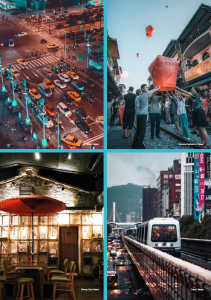
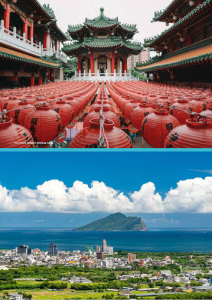
During the Alishan Cherry Blossom Festival, thousands of visitors come to see the gorgeous pink flowers. As you continue on the path, you will see a number of sacred tree relics, including the Elephant Tree Trunk (an old cypress tree stump that looks like an elephant trunk) and the Three Generation Tree, where three generations of cypress trees had grown on top of one another.
Further up nearing the Sacred Tree Station, you will find the Alishan Sacred Tree. This is Alishan’s oldest and most famous tree. It is more than 3,000 years old and symbolises new life. After being struck by lightning in the 1950s, the authorities eventually decided to cut it down and lay it on its side. Today, the tree is marked as one of the top five wonders of Alishan.
If you are staying overnight at Alishan, it is recommended that you try to catch the famous Alishan sunrise the next morning at the sunrise viewing platform. To do so, you will need to book the Alishan sunrise train one day prior. The ticket can be bought at several places, including the Alishan Forest Railway booth in Chiayi, Fenqihu or the main Alishan Station. Do note that the exact departure time of the sunrise train is only announced at 4:30pm each day prior, so do remember to check the notice board by the ticketing booths as this is different every day.
KAOHSIUNG AND KENTING
Kaohsiung and Kenting mark the final stops in our journey around Taiwan. Known as Taiwan’s “Maritime Capital” due to its huge maritime related industries, Kaohsiung has worked hard to shed its dour image and spruce up its tourism industry. It now sports plenty of hipster cafes, river and harbour side parks, cultural sites, beautiful beaches, and colourful street art.
First off, to get a bird’s eye view of the city, head down to 85 Sky Tower – the tallest building in Kaohsiung and the second tallest in Taiwan (after Taipei 101). To get to the building, take the local MRT to the Sanduo Shopping District Station. Standing at 378m, 85 Sky Tower is huge and you can spot it just about anywhere in the city. The observation deck, located on Level 75, offers breath taking views over the cityscape and harbour. To get the best view, come at sunset to watch the sun melt away over the horizon. It is an epic view you will not want to miss.
Taipei, Taiwan
Another place you may want to visit is Fo Guang Shan Monastery, located at the city’s outskirts. The journey is a bit complicated, and usually involves a train ride and a bus transfer. However, the journey will be worth it. The complex is home to beautiful temples, towering pagodas and several exhibition halls where you can learn more about Buddhism. The complex’s main attraction is the enormous Buddha – the largest bronze-seated Buddha in the world – that sits at the edge of the complex. Within the Fo Guang Shan Museum’s Main Exhibition Hall, you will find an array of ancient artifacts and sacred artworks that make for some interesting browsing. After browsing through the exhibits, you can head to the roof where you will get a close-up look at the 108m tall Buddha.
Another temple you might want to drop by is Sanfeng Temple, located in the heart of Kaohsiung. The temple is about a 20–25-minute walk from Formosa Boulevard Station. Sanfeng Temple is dedicated to Nezha – a deity of protection, and has a rich history dating back more than 300 years. While it might not be the most important temple in Taiwan, Sanfeng Temple is certainly one of the most photogenic. Its large decorated wooden doors open up to a huge courtyard strewn with dozens of dangling red lanterns. Despite being extremely beautiful, Sanfeng Temple is not yet well-known so you will not find this place to be overcrowded with tourists. For the best views over the temple and lanterns, take the staircase near the entrance to the upper balconies.

From Kaohsiung, we now head on down to the final destination in our itinerary – Kenting, also known as the premier beach destination in Taiwan. To get to Kenting from Kaohsiung, the easiest way is to take the Kenting Express Bus, which departs from Kaohsiung HSR Station. Although there are several buses a day, do make sure to time your visit as waiting times can sometimes take up to an hour.
When you reach Kenting, you will understand why it is greatly loved by locals, with its pristine white sandy beaches, turquoise waters, lush tropical forests and stretched-out seaside cliffs. Kenting is home to some of the most beautiful beaches in Taiwan, and there are several fantastic beaches to choose from, including Nanwan, Little Bay, Kenting Beach, Sail Rock, and Baisha. In fact, the latter beach was where Taiwanese auteur Lee Ang shot his Oscar winning Life of Pi. Kenting’s beaches are relatively well spread out, and you will need transport to access the less accessible ones like Nanwan, Baisha and Sail Rock. But if you are sticking to the main tourist area, Kenting Beach and Little Bay are within walking distance. Besides swimming and chilling at these beautiful beaches, most of these locations also offer a wide variety of water sports activities, including jet ski rides, banana boat rides and snorkelling.
If you are staying beyond sunset in Kenting and are feeling peckish from swimming and other daytime marine activities, head on down to Kenting Night Market – one of Taiwan’s most famous night markets – to get some local food to fill up your hungry tummy. Here, you will find the usual Taiwanese fare like stinky tofu and Taiwanese sausage as well as a fantastic selection of fresh and tasty seafood like oysters, giant squid, clams, tiger prawns, sea urchins, and all kinds of fish!
Kenting Night Market is huge and lines both sides of Kenting Street. Most vendors start to open up at around 5pm, and the place can get very busy from 7pm onwards. Come hungry, wear comfortable walking shoes, and get ready to join the crowds!
TREASURES OF ILHA FORMOSA
Over and beyond the destinations listed, there are many other places of astonishing beauty and history not covered in this article. If you have the time, head on to other places like Taroko Gorge (at Hualien) to discover the many treasures of Ilha Formosa. Taiwan is a treasure island full of beautiful nature, rich history and fantastic eats that are just waiting to be discovered.










